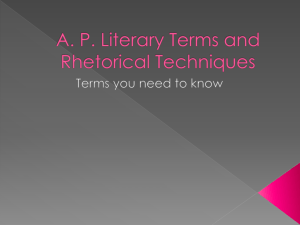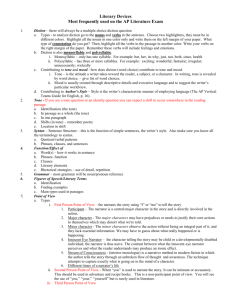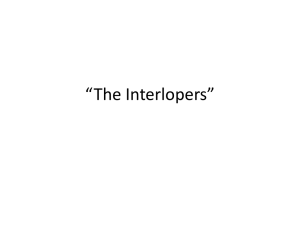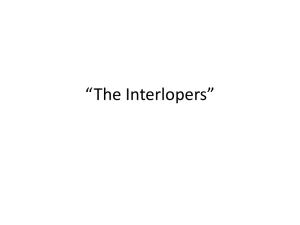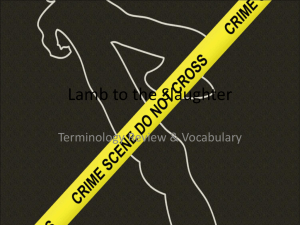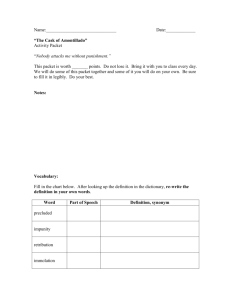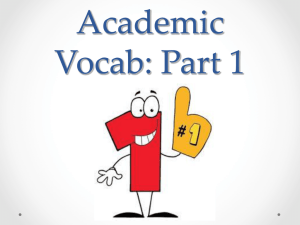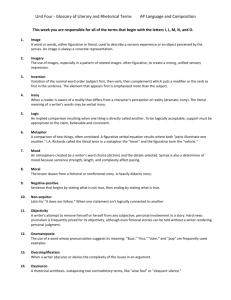AP Terms
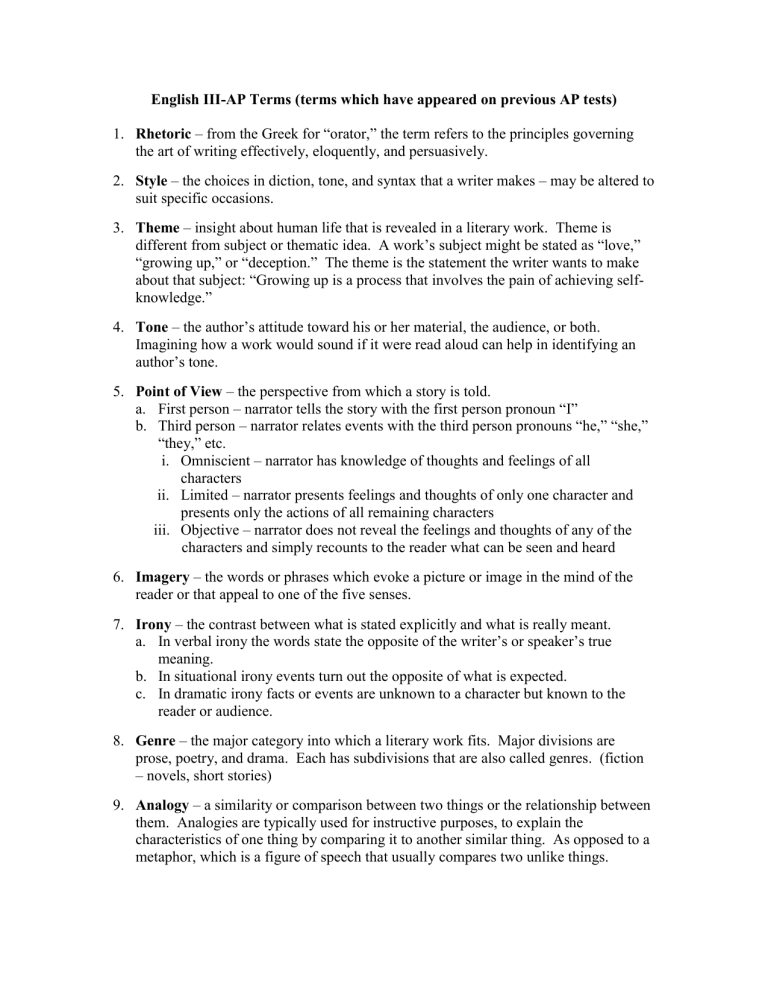
English III-AP Terms (terms which have appeared on previous AP tests)
1.
Rhetoric – from the Greek for “orator,” the term refers to the principles governing the art of writing effectively, eloquently, and persuasively.
2.
Style – the choices in diction, tone, and syntax that a writer makes – may be altered to suit specific occasions.
3.
Theme – insight about human life that is revealed in a literary work. Theme is different from subject or thematic idea. A work’s subject might be stated as “love,”
“growing up,” or “deception.” The theme is the statement the writer wants to make about that subject: “Growing up is a process that involves the pain of achieving selfknowledge.”
4.
Tone – the author’s attitude toward his or her material, the audience, or both.
Imagining how a work would sound if it were read aloud can help in identifying an author’s tone.
5.
Point of View – the perspective from which a story is told. a.
First person – narrator tells the story with the first person pronoun “I” b.
Third person – narrator relates events with the third person pronouns “he,” “she,”
“they,” etc. i.
Omniscient – narrator has knowledge of thoughts and feelings of all characters ii.
Limited – narrator presents feelings and thoughts of only one character and presents only the actions of all remaining characters iii.
Objective – narrator does not reveal the feelings and thoughts of any of the characters and simply recounts to the reader what can be seen and heard
6.
Imagery – the words or phrases which evoke a picture or image in the mind of the reader or that appeal to one of the five senses.
7.
Irony – the contrast between what is stated explicitly and what is really meant. a.
In verbal irony the words state the opposite of the writer’s or speaker’s true meaning. b.
In situational irony events turn out the opposite of what is expected. c.
In dramatic irony facts or events are unknown to a character but known to the reader or audience.
8.
Genre – the major category into which a literary work fits. Major divisions are prose, poetry, and drama. Each has subdivisions that are also called genres. (fiction
– novels, short stories)
9.
Analogy – a similarity or comparison between two things or the relationship between them. Analogies are typically used for instructive purposes, to explain the characteristics of one thing by comparing it to another similar thing. As opposed to a metaphor, which is a figure of speech that usually compares two unlike things.
10.
Satire – a work that targets human vices and follies or social institutions and conventions for reform or ridicule. Devices used by the satirist include irony, wit, parody, caricature, hyperbole, litotes, and sarcasm.
11.
Parody – a work that closely imitates the style or content of another with the specific aim of comic effect or ridicule.
12.
Allegory – the device of using character and/or story elements symbolically to represent an abstraction in addition to the literal meaning. A character may represent truth or freedom, for example.
13.
Anecdote – a short account of a particular incident or event, especially of an interesting or amusing nature, used to develop a point or to inject humor into a text.
14.
Diction – the writer’s word choices. Words such as formal, informal, ornate, or plain describe a writer’s diction.
15.
Denotation – the literal dictionary definition of a word, devoid of any emotion or attitude.
16.
Connotation – the nonliteral, associative meaning of a word, the implied, suggested meaning. Example: “odor” and “aroma” mean the same thing but have different connotations.
17.
Vernacular – the language spoken by the people who live in a particular locality.
18.
Colloquial/Colloquialism – the use of slang or informalities in speech or writing which gives a work a conversational, familiar tone. In writing, colloquial expressions include local or regional dialects.
19.
Euphemism – a more agreeable or less offensive substitute for an unpleasant term
(eg. “earthly remains” instead of “corpse”).
20.
Oxymoron – the joining of apparently contradictory words to suggest a paradox. (i.e., deafening silence, sweet sorrow, Dodge Ram)
21.
Malapropism – the substitution of an incorrect word for a word with a similar sound, especially with humorous results. (i.e., he’s not a fan of the electrical college.)
22.
Metonymy – the name of one object is substituted for another closely associated with it. (The White House declared…Wall Street predicts.)
23.
Synecdoche – a part of a thing stands for the whole. (All hands on deck. That’s a great set of wheels.)
24.
Sarcasm – from Greek “to tear flesh,” sarcasm is verbal irony that often involves bitter, caustic language meant to hurt or ridicule someone or something.
25.
Tautology – an unnecessary and/or redundant repetition of meaning, using dissimilar words that effectively say the same thing. (i.e., added bonus, free gift, reason why)
26.
Syntax – the way a writer chooses to join words into phrases, clauses, and sentences.
Syntax refers to groups of words, while diction refers to the individual words.
27.
Parallelism – the rhetorical framing of words, phrases, sentences, or paragraphs to give structural similarity. The type of parallelism in which the same words are used is called anaphora.
28.
Chiasmus – a type of balance in which the second part is balanced against the first but with parts reversed. Example: “He did, did he?” “Out went the taper as she hurried in.” [Chi is the Greek letter for X.]
29.
Antithesis – balancing or contrasting one word or idea against another, usually in the same sentence.
30.
Ellipsis – the omission of a word or words that can be inferred by the reader. (i.e.,
John can play the guitar, and Mary can play
the piano.)
31.
Zeugma – a construction in which one word is placed in the same grammatical relationship to two words but in quite different senses. From Greek word for “yoke.”
Example: He bolted the door and his dinner. You held your breath and the door for me.
32.
Spoonerism – an accidental interchange of sounds in two or more words: like
“blushing crow” instead of “crushing blow.” Named for Dr. W. A. Spooner of New
College, Oxford, who once told a lazy student, “You’ve hissed all your mystery lectures and tasted two whole worms.”
33.
Allusion – a usually indirect reference to something that presumably is commonly known; can be historical (i.e., referring to the Holocaust), literary (i.e., referring to
Romeo and Juliet ), mythical (i.e., referring to Hercules), Biblical (i.e., referring to
Moses), popular cultural (i.e., referring to Justin Bieber), etc.
34.
Hyperbole – a figure of speech using deliberate exaggeration or overstatement.
35.
Aphorism – a terse statement that expresses a general truth or moral principle.
36.
Onomatopoeia – a figure of speech in which natural sounds are imitated in the sounds of words. (buzz, hiss, crackle)
37.
Symbol – anything that represents something else.
38.
Apostrophe – a figure of speech that directly addresses an absent or imaginary person or a personified abstraction.
39.
Litotes – steep understatement or the ironic minimizing of fact, often through double negative. (It was not a pretty picture. He’s not unattractive.)
40.
Paradox – a statement that appears to be self-contradictory or opposed to common sense but upon closer inspection contains some degree of truth or validity.
41.
Antecedent – the word, phrase, or clause referred to by a pronoun.
42.
Invective – an emotionally violent, verbal denunciation or attack using strong, abusive language. (Synonyms: diatribe, tirade, philippic)
43.
Didactic – a term describing works that have the primary aim of teaching or instructing, especially the teaching of moral or ethical principles.
44.
Syllogism – a deductive system of formal logic that presents two premises (the first one called “major” and the second one “minor”) which inevitably lead to a given conclusion.
Major premise – All men are mortal.
Minor premise – Socrates is a man.
Conclusion – Therefore, Socrates is mortal.
45.
Ad hominem – an argument that attacks another’s position as invalid or weak because of a human failing that has nothing to do with that position.
46.
Motif – an often-repeated character, incident, or idea with symbolic significance.
47.
Stream of Consciousness – a style of writing in which the thoughts and feelings of the writer or narrator are recorded as they occur.
48.
Epiphany – literally, a manifestation or showing forth, usually of some divine being.
In literature, an event in which the essential nature of something (person, object, situation) is suddenly perceived – a sudden insight, a revelation.
49.
Polemic – a vigorously argumentative work, setting forth its author’s attitudes on a controversial subject – usually religious, political, or social issues. Writing can be polemical in tone.
50.
Anachronism – a chronological misplacing of persons, events, objects, or customs in regard to each other. (i.e., if Hester Prynne were to say “YOLO!” to Dimmesdale)

